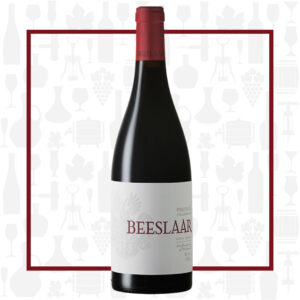Cellar Profile
Having grown up in a wine region, it wasn’t entirely surprising that Abrie Beeslaar changed from studying medicine at the University of Stellenbosch, to graduating with a BSc in Viticulture and Oenology from there. In 2003, Abrie became the Head Winemaker at acclaimed and iconic winery (and Pinotage specialist), Kanonkop. There, he discovered a tiny, 2.5 hectare, old bush-vine-trained Pinotage vineyard near Simonsberg Mountain, outside Stellenbosch that had the perfect conditions for creating magnificent wines. Shale soils, easterly breezes and significant diurnal shifts, coupled with the bush vines’ penchant for giving small bunches of tiny, ripe berries give the wines intensity of colour and concentration. Beeslaar Estate Pinotage is vinified similarly each year, but the finished wine always tells the tale of the vintage and is generally regarded as amongst the finest examples of Pinotage in the world. The winery recently added a small production of Western Cape Chardonnay to its line up.
Region
Located at the edge of the Stellenbosch appellation, 45 km from Cape Town, Simonsberg has been actively planted since the 17th century. It is a small region, known for crafting some of the finest examples of South African wine. Located in the foothills leading to the Simonsberg Mountains towering above it, it is bordered by Stellenbosch, Paarl and Franschhoek. Simonsberg enjoys a Mediterranean climate, with cool, wet winters and hot summers, mitigated by a strong easterly wind and fairly significant diurnal shifts.
Vineyard
Old vine vineyard, situated in Simonsberg, just outside Stellenbosch. At 200 masl, the bush trained vines are planted in shale soil. There is a strong, easterly breeze that whistles through the vineyard, cooling the grapes and restricting growth of the bush vines, keeping berry sizes and clusters smaller, allowing for full phenolic ripening of the skins, vital for top notch Pinotage.
Varieties
Pinotage is a South African crossing of Pinot Noir and Cinsault. It is typically found in South Africa (Stellenbosch), but its brambly nature, ability to maintain a level of freshness even in hot conditions and consistency vintage to vintage has found it being increasingly planted worldwide. It doesn’t crop as hugely as some reds, but still gives decent yields. Attention in the vineyard must be observed to avoid isoamyl acetate, which gives off unpleasant drying paint notes. An unabashedly “New World” variety.
Winemaking
Hand-picked grapes were de-stemmed, sorted and fermented in open-top concrete fermenters with manual punchdowns every 2 hours to extract the right amount of colour and tannin. The wine is then placed in a combination of new and second fill 225L French oak barriques for 20 months, where it undergoes malolactic fermentation and maturation.
Tasting Notes
This is one of the world’s finest examples of the Pinotage – nothing like the mass-marketed, candied, coffee-and-sweet-chocolate, inexpensive and forgettable versions. There are some of the typical rough, edgy, savoury elements on the nose, but they are tempered by layers of blackberry, cassis, prune, tomato leaf and toast. The palate is full and smooth, although there are decent tannins and tons of fresh acidity. Decant, then enjoy with lamb shank, hearty winter stews or BBQ ribs.

 info@buyersandcellars.ca
www.buyersandcellars.ca
info@buyersandcellars.ca
www.buyersandcellars.ca